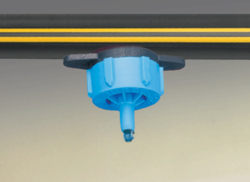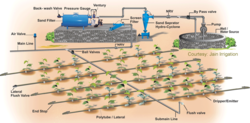Irrigation
Irrigation is when people add water to plants, to help them grow when there is not enough rain. Irrigation water can be pumped from rivers, natural lakes or lakes created by dams, from wells or allowed to flow to the fields by or open canals.
Types of Irrigation
There are many different types of irrigation methods. The most common ones are:
- Sprinkler Irrigation
- Drip irrigation
- Surface irrigation
- Sub surface irrigation
- Manual irrigation
Sprinkler irrigation mimics natural rainfall where water falls on the plants. In sprinkler irrigation, water is moved through pipes to sprinklers scattered around and within the field. The Sprinklers shoot water from pressurized outlets or guns from pipes into the air which then fall on the plants. Center pivot irrigation is a type of sprinkler irrigation. It's basically, sprinklers on wheels.
In drip irrigation, water drips directly to the roots of plants from pipes which have small holes or special emitters spaced along the pipe. Drip irrigation is more efficient than other irrigation methods because water is applied directly or close to plants' roots i.e. where it is needed. Thus, it uses less water, reduces leeching of soil nutrients and erosion of top soil.
In Surface irrigation, water from a source such as rivers, pipes, dams, canals e.t.c. floods the soil surface. Surface irrigation uses a lot of water compared to other irrigation methods. It could also drain nutrients beyond the reach of the plant roots. If the water is excessive, it could cause damage to the plant. However, surface irrigation is used extensively in rice farming. This is because the permanent flooding acts as a natural pest control method[1] and rice can survive waterlogged soil.
Sub-Surface irrigation is when water comes from below the surface of the soil. Sub-surface irrigation create an artificial water table to place water right within reach of plants. Water seeps through the walls into the soil of farms from canals passing through and/or around the farm. Drip irrigation becomes sub-surface irrigation when the pipes are placed underground.
With Manual irrigation irrigation is done by humans using buckets, pipes or watering cans. It is labor-intensive and inefficient.
Impacts
Irrigation can let more crops be grown on the same land, or allow a crop to grow in a dry period. It is expensive and care should be taken to ensure that the benefits from increased crop yields are not exceeded by the installation and operating costs of the irrigation scheme.
Irrigation causes a subsequent rise in water-tables. If saline water is below, it may rise to the surface. Sometimes salinity becomes high enough to kill the plants. Irrigation water itself can carry salt and sometimes other toxic materials that hurt the plants. To prevent this, irrigation projects must also assure good drainage.
Irrigation Media
Irrigation of agricultural fields in Andalusia, Spain. Irrigation canal on the left.
Traditional irrigation channel in Switzerland, collecting water from the high Alps
Irrigation is underway by pump-enabled extraction directly from the Gumti, seen in the background, in Comilla, Bangladesh.
Grapes in Petrolina, Brazil only made possible in this semi arid area by drip irrigation
Basin flood irrigation of wheat
References
- ↑ Tindall, Kelly V.; Bernhardt, John L.; Stout, Michael J.; Beighley, Donn H. (2013). "Effect of depth of flooding on the rice water weevil, Lissorhoptrus oryzophilus, and yield of rice". Journal of Insect Science (Online). 13 (62): 62. doi:10.1673/031.013.6201. ISSN 1536-2442. PMC 3740922. PMID 23906324.










